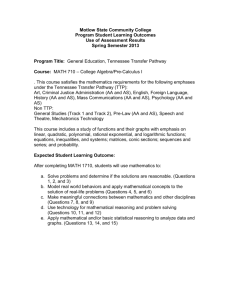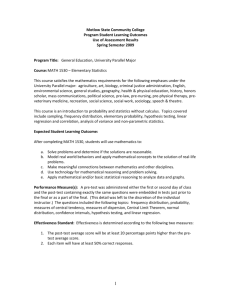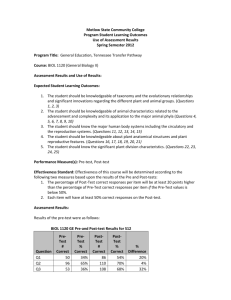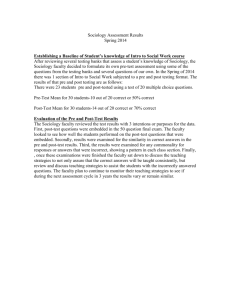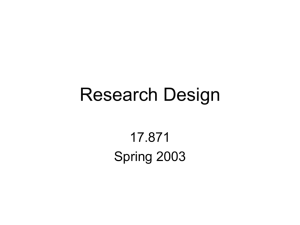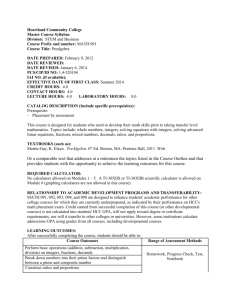use of assessment results - Motlow State Community College
advertisement
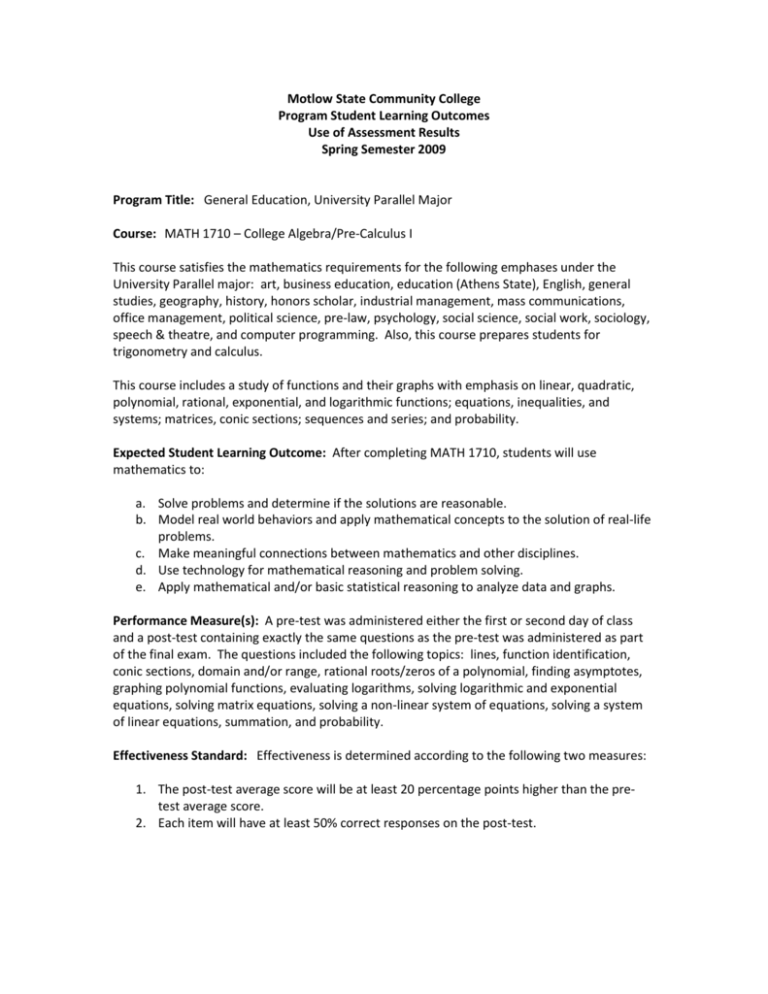
Motlow State Community College Program Student Learning Outcomes Use of Assessment Results Spring Semester 2009 Program Title: General Education, University Parallel Major Course: MATH 1710 – College Algebra/Pre-Calculus I This course satisfies the mathematics requirements for the following emphases under the University Parallel major: art, business education, education (Athens State), English, general studies, geography, history, honors scholar, industrial management, mass communications, office management, political science, pre-law, psychology, social science, social work, sociology, speech & theatre, and computer programming. Also, this course prepares students for trigonometry and calculus. This course includes a study of functions and their graphs with emphasis on linear, quadratic, polynomial, rational, exponential, and logarithmic functions; equations, inequalities, and systems; matrices, conic sections; sequences and series; and probability. Expected Student Learning Outcome: After completing MATH 1710, students will use mathematics to: a. Solve problems and determine if the solutions are reasonable. b. Model real world behaviors and apply mathematical concepts to the solution of real-life problems. c. Make meaningful connections between mathematics and other disciplines. d. Use technology for mathematical reasoning and problem solving. e. Apply mathematical and/or basic statistical reasoning to analyze data and graphs. Performance Measure(s): A pre-test was administered either the first or second day of class and a post-test containing exactly the same questions as the pre-test was administered as part of the final exam. The questions included the following topics: lines, function identification, conic sections, domain and/or range, rational roots/zeros of a polynomial, finding asymptotes, graphing polynomial functions, evaluating logarithms, solving logarithmic and exponential equations, solving matrix equations, solving a non-linear system of equations, solving a system of linear equations, summation, and probability. Effectiveness Standard: Effectiveness is determined according to the following two measures: 1. The post-test average score will be at least 20 percentage points higher than the pretest average score. 2. Each item will have at least 50% correct responses on the post-test. Assessment Results: 1. Assessment results showed a 32 percentage point gain from pre-test to post-test, as the average of the pre-test scores was 23 and the average of the post-tests was 55. 2. Post-test data from item analysis, however, indicate that 53 or more of the 104 students (i.e. more than 50%) responded incorrectly to problems concerning asymptotes, rational roots/zeros, conic sections, probability, and summation. Results of the pre-test were as follows: (104 students) Expected Student Learning Outcome a a a b b b c c c d d d e e e Question number Number Missed 1 2 3 4 5 6 7 8 9 10 11 12 13 14 15 79 93 87 82 75 64 84 77 89 80 92 78 77 76 69 Number Correct % missed 25 11 17 22 29 40 20 27 15 24 12 26 27 28 35 76% 89% 84% 79% 72% 62% 81% 74% 86% 77% 88% 75% 74% 73% 66% % correct 24% 11% 16% 21% 28% 38% 19% 26% 14% 23% 12% 25% 26% 27% 34% Results of the post-test were as follows: (104 students) Expected Student Learning Outcome a a a b b b c c c d d Question number Number Missed Number Correct % missed % correct Change in Percentage points 1 2 3 4 5 6 7 8 9 10 11 67 52 56 65 35 42 50 30 data 40 61 37 52 48 39 69 62 54 74 not 64 43 64% 50% 54% 62% 34% 40% 48% 29% available 38% 59% 36% 50% 46% 38% 66% 60% 52% 71% on 62% 41% +12 +39 +30 +17 +38 +22 +33 +45 item +39 +29 d e e e 12 13 14 15 33 29 17 37 71 75 86 67 32% 28% 16% 36% 68% 72% 84% 64% +43 +46 +57 +30 One hundred four (104) students took both the pre-test and the post-test. The average of the pre-test scores was 23% and the average of the post-test scores was 55%. Assessment results showed a 32 percentage point gain from pre-test to post-test, thus meeting the effectiveness standard that the post-test average score be at least 20 percentage points higher than the pretest average score. The effectiveness standard that each item will have at least 50% correct responses on the posttest was met by all problems except 1, 3, 4, and 11. Question 2, which deals with statistics, specifically arithmetic sequences, had exactly 50 % correct responses. It should be mentioned that due to a typographical error on the post-test data for question 9 was considered to be invalid. The error will be corrected the next time the test is given. Use of Assessment Results: The initial teaching of the items identified in the item analysis as needing improvement occurs in this course; therefore, faculty will place emphasis on the areas with 52 or more incorrect posttest responses so that when MATH 1710 is assessed in spring 2011, according to the assessment cycle, results should indicate gains have been made in student learning. Pre-test questions 2, 3, 7, 9, and 11 were missed by 80% or more of the students who took the test. Except for questions 2 and 7, these same questions were missed by less than 50% of the students on the post-test, indicating that the time spent on these topics in class was probably adequate. Question 2 was missed by exactly 50% of the students who took the post-test. In looking at the post-test percentages, it can be easily seen that rational functions (question 1), arithmetic sequences (question 2), solving rational equations (question 3), conics (question 4), and summations (question 11) are all areas which need to be emphasizes the next time MATH 1710 is taught. These topics are the only ones missed by 50% or more of the students on the post-test. Faculty will begin to put more emphasis on these areas so that when MATH 1710 is assessed in spring 2011, according to the assessment cycle, gains will be made in student learning.
